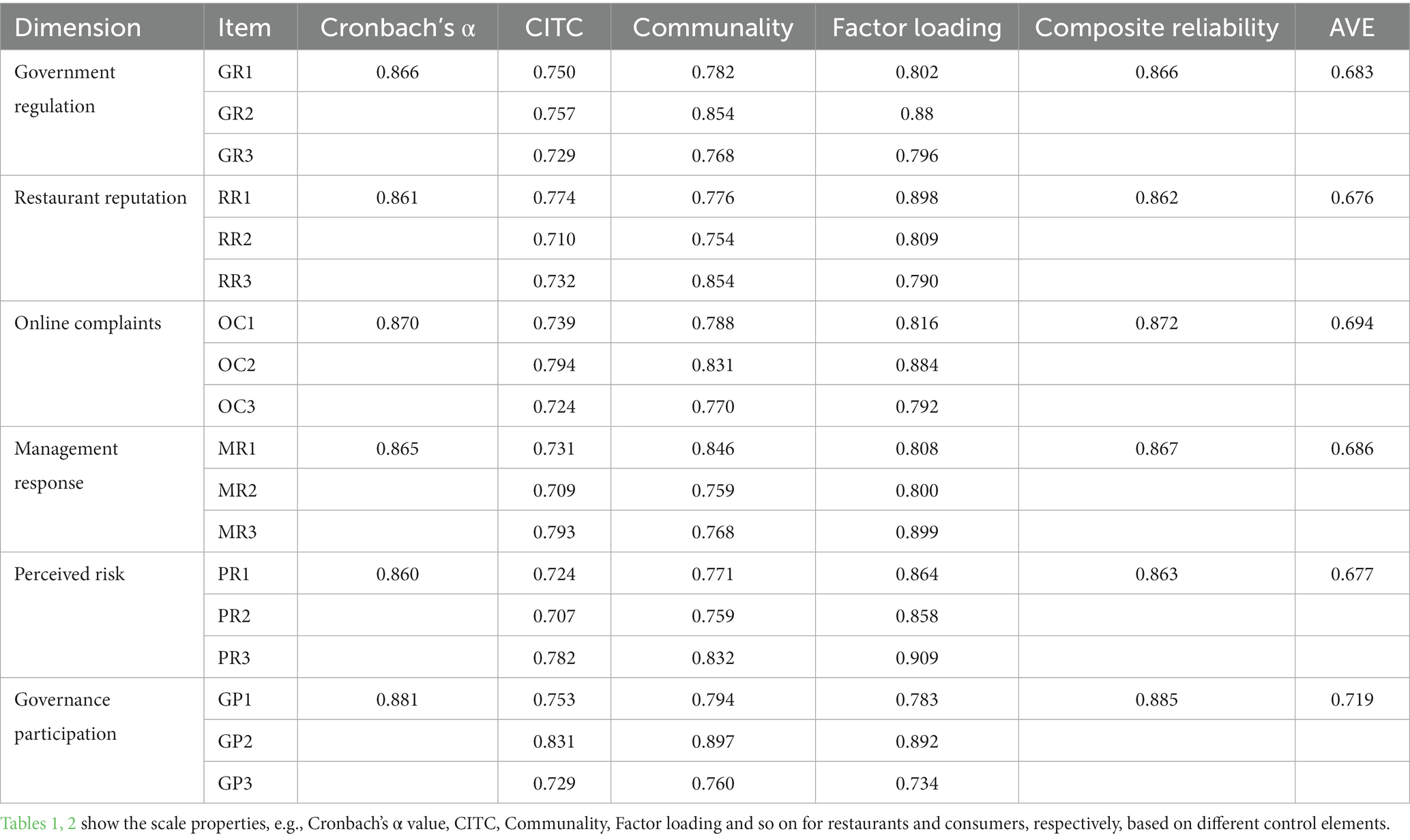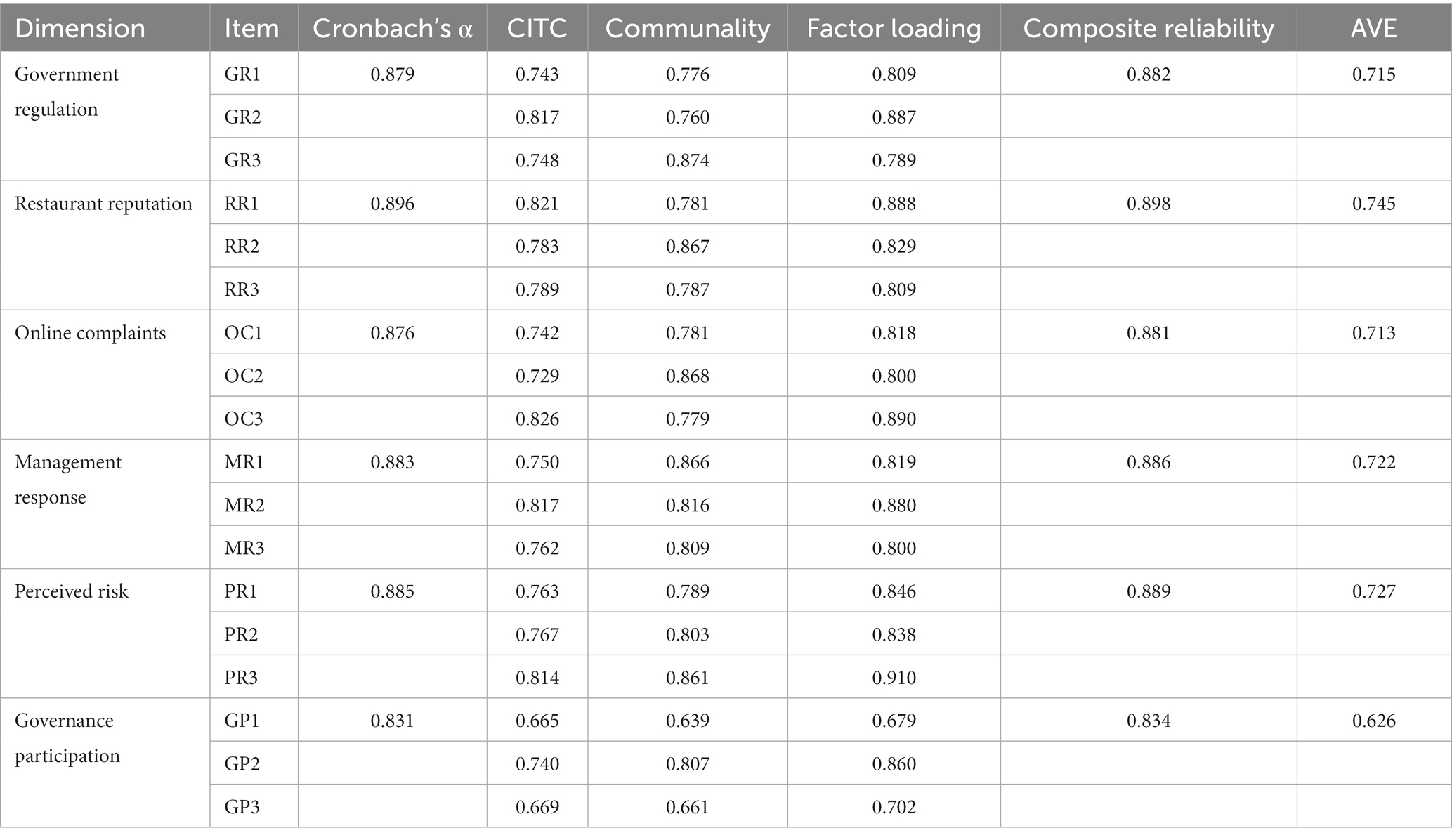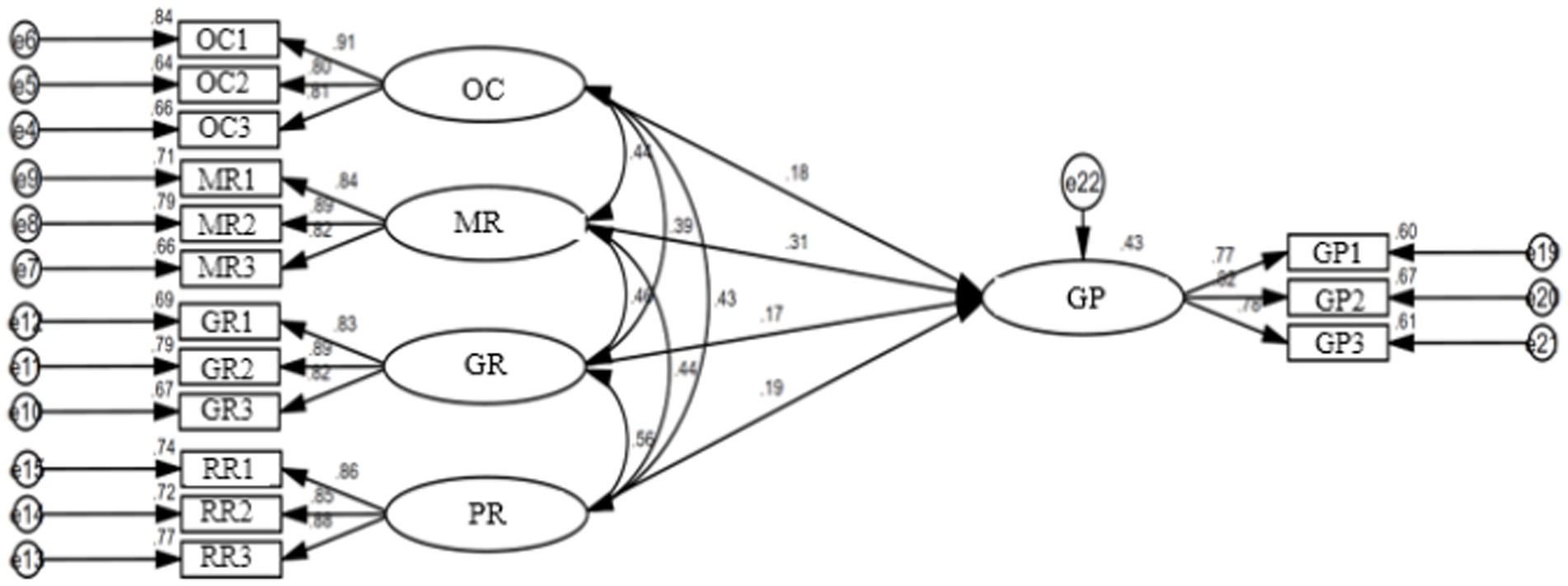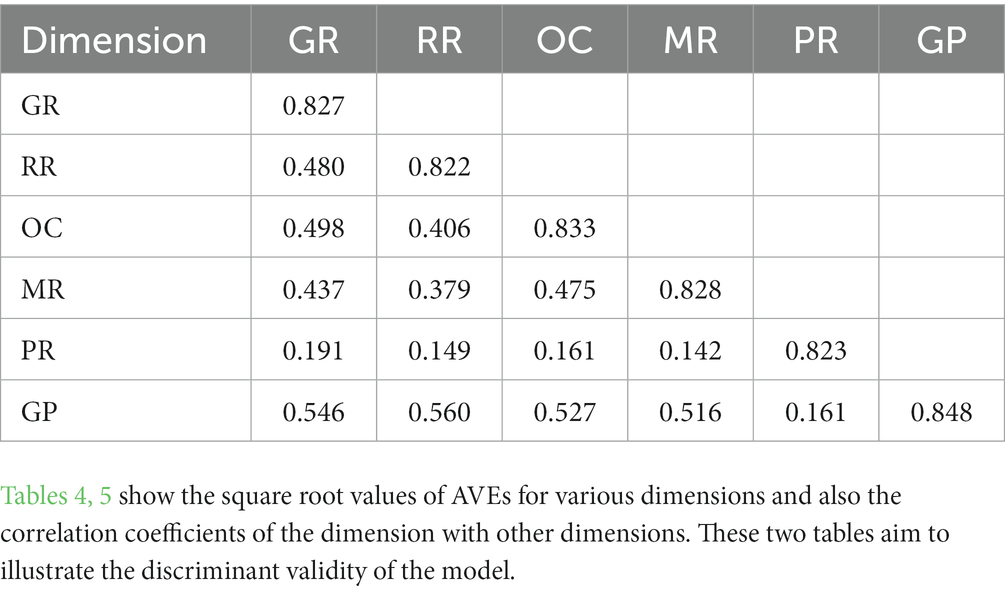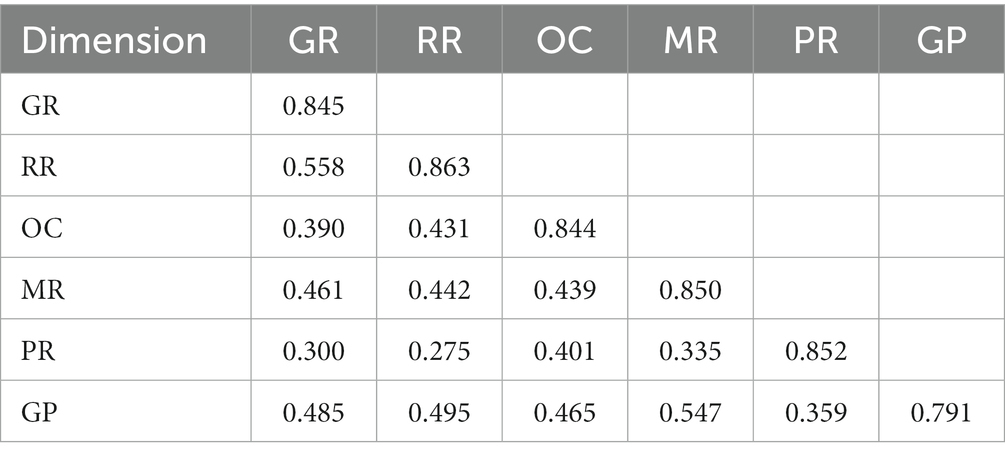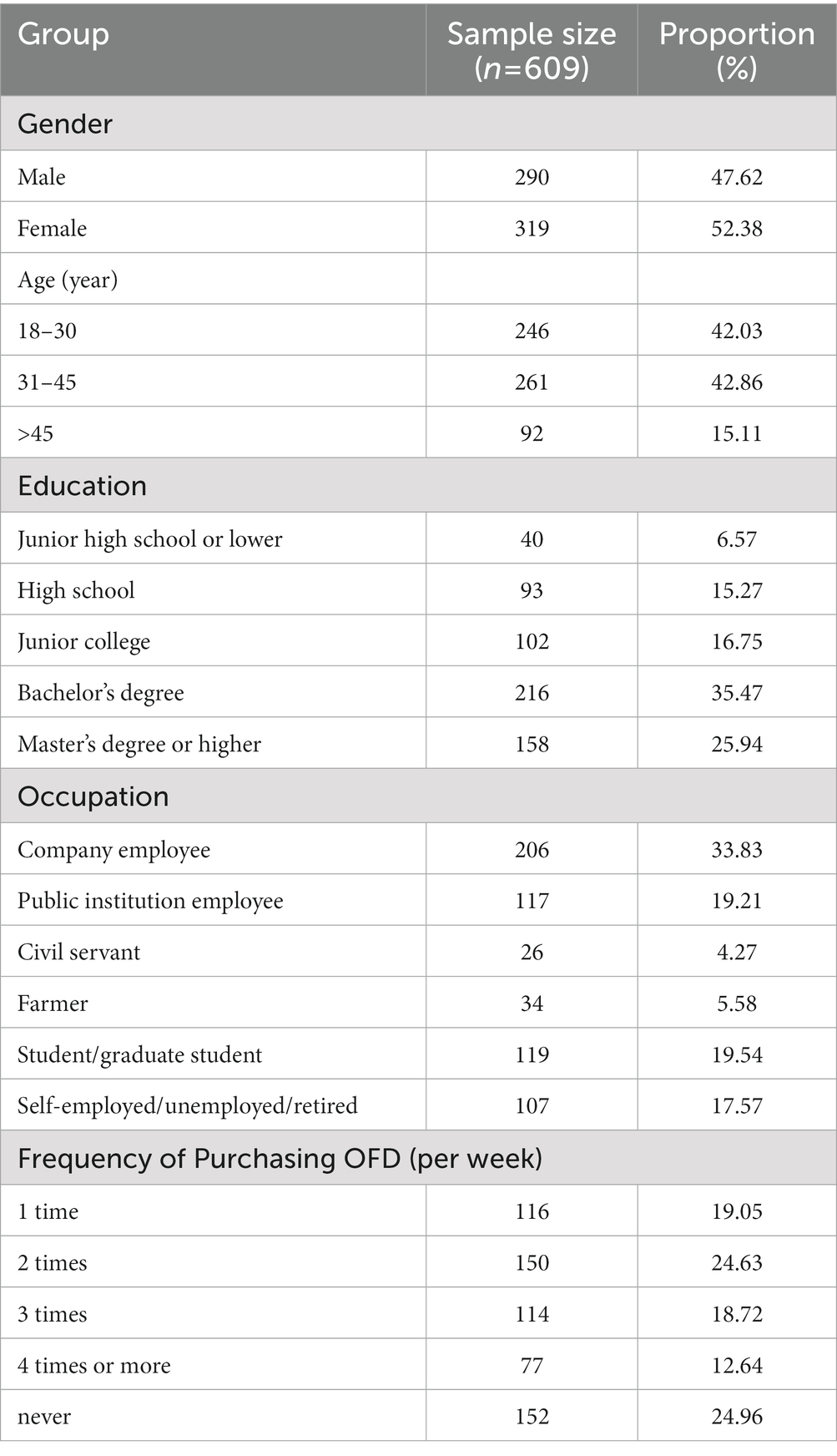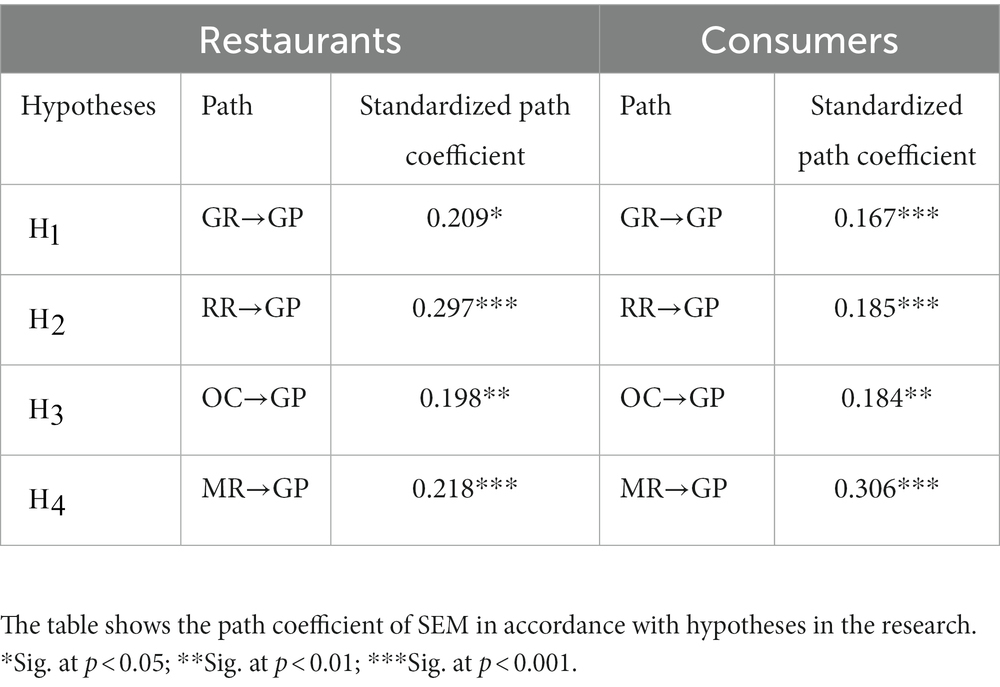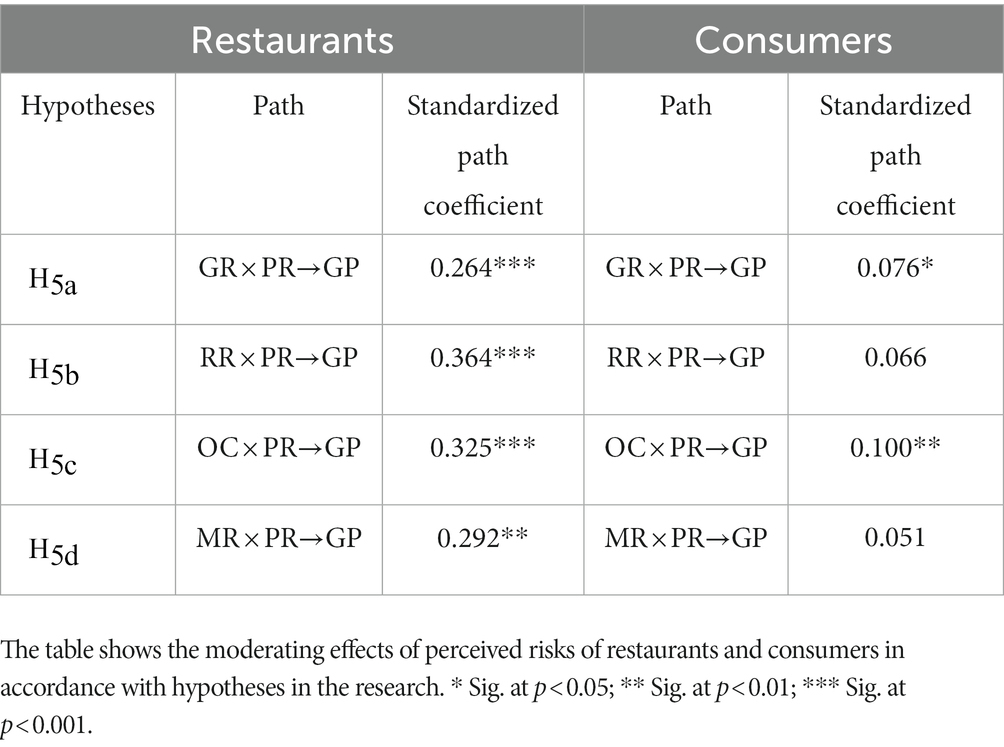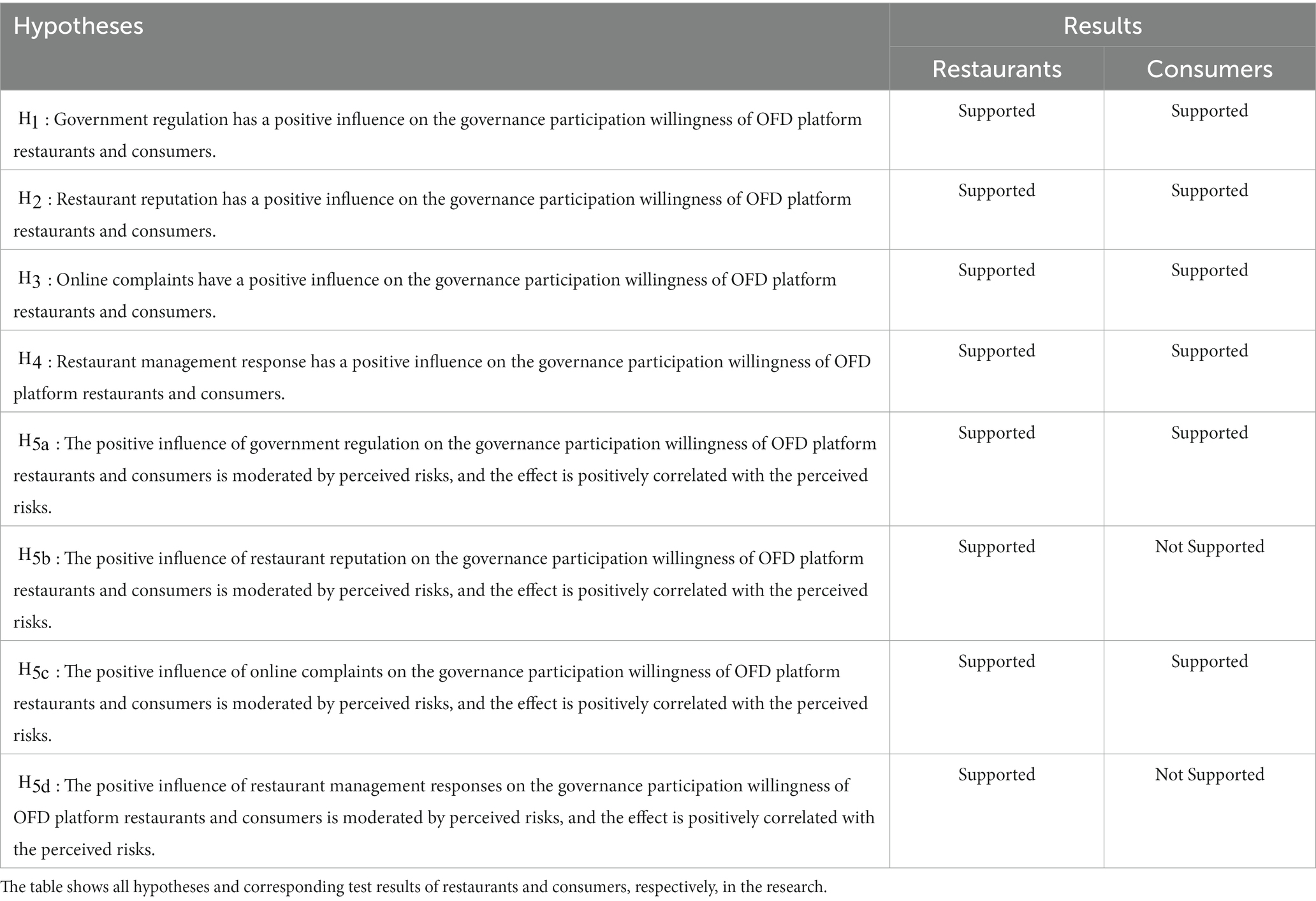- 1School of Business, Jiangnan University, Wuxi, China
- 2Institute for Food Safety Risk Management, Jiangnan University, Wuxi, China
The popularization of the Internet and the convenience of e-commerce are driving the online restaurant industry’s rapid development of worldwide. However, serious information asymmetries in online food delivery (OFD) transactions not only aggravate food safety risks, resulting in simultaneous government and market failures, but also intensify consumers’ perceived risks. This paper innovatively constructs a research framework for the governance participation willingness of OFD platform restaurants and consumers under the moderating effects of perceived risks from the perspective of control theory and then develops scales for analyzing the governance willingness of both restaurants and consumers. Using data collected through a survey, this paper explores the effect of control elements on governance participation by restaurants and consumers and analyzes the moderating effects of perceived food safety risks. Results showed that both government regulations and restaurant reputation (formal control elements) and online complaints and restaurant management response (informal control elements) can increase governance participation willingness among both platform restaurants and consumers. The moderating effects of perceived risks are partially significant. When the risks perceived by restaurants and consumers are strong, government regulation and online complaints can more effectively boost the governance participation willingness of restaurants and consumers, respectively. At this moment, consumers’ willingness to pursue problem solving through online complaints is evidently enhanced. Accordingly, the perceived risks and the online complaints jointly motivate restaurants and consumers to participate in governance activities.
1. Introduction
In recent years, the platform economy has risen rapidly worldwide, promoting the quick development of the online restaurant industry – a novel food consumption format (Kassi and Lehdonvirta, 2018; Cho et al., 2019; Cheng et al., 2021). Different types of online food delivery (OFD) platforms, represented by Uber Eats in the US, Deliveroo in UK, Swiggy in India, iFood in Brazil, and Eleme and Meituan in China, have been growing rapidly (Gunden et al., 2020; Li et al., 2020). OFD has gradually become an important method of daily food purchases; in particular, its popularity boomed as part of prevention and control of the COVID-19 pandemic (Gao et al., 2020; Oncini et al., 2020; Li et al., 2022; Lu et al., 2022). The online restaurant industry has relatively optimistic development prospects for the future. According to estimations, the global OFD market will continue growing at a mean annual rate of 8.28% during 2022–2026. China’s current OFD consumption has reached a huge scale of 544 million person-times (China Internet Network Information Center (CNNIC), 2022), and over 40% of restaurants now provide consumers with parallel online and offline services (Huaan Securities, 2021).
The quickly developing, large-scale, multi-user OFD platforms serve to directly connect numerous dispersed food producers and operators with millions upon millions of consumers. However, because OFD transactions are characterized by virtuality, invisibility, and complexity, OFD platforms can increase information asymmetries (Du et al., 2019), bringing new concerns to governments’ traditional food regulatory system and new challenges to the traditional reputation-based market governance mechanism. Simultaneous government and market failures may occur in OFD food safety risk governance (Zhang, 2021), which infringes consumers’ right to health. Accordingly, it has been of great urgency to establish and improve a collaborative governance mechanism for OFD food safety risk participated in by all stakeholders including restaurants and consumers.
China has the largest OFD market, whose scale is unmatched by those in other countries (Statista, 2023). In this sense, studying the food safety risk governance of China’s OFD platforms is somewhat unique, forward-looking, and representative. The contribution of this paper lies in innovatively constructing a research framework for measuring the governance participation willingness by OFD platform restaurants and consumers under the moderating effects of perceived risks from the perspective of control theory. This study also contributes to the literature by independently developing scales for analyzing the governance participation willingness of restaurants and consumers based on the Chinese context, verifies the scales’ effectiveness, and studies the influences of control elements and perceived risk elements on both platform restaurants’ and consumers’ willingness to participate in governance by analyzing collected sample data using the structural equation model (SEM) and latent moderated structure (LMS) model in a combined manner.
2. Literature review
Given OFD platforms’ ability to cater to consumers’ diversified and convenient food consumption demands, they have spurred the emergence of large numbers of ghost kitchens1 existing in the UK, US, India, and China with the rapid development of the online restaurant industry (Nita, 2019; Belleri, 2020). These ghost kitchens pose food safety risks, and their potential to cause health issues among consumers is a concern (Li et al., 2020). Links such as packaging and distribution are included in OFD, unlike traditional food consumption formats, so there is a risk of secondary food contamination. For example, food overflow to the packaging box often occurs during distribution of restaurant food. In particular, residues in the distribution box can become a culture medium for microbial growth under hot weather conditions; a distributor whose sanitary conditions may not meet standards has many opportunities to make contact with and contaminate food. In addition, it is possible to contaminate food via the packaging materials in the added packaging link, and so on (Zhang, 2021). More seriously, there are many moral hazards for greater economic benefits in the online food transaction market; for example, bad restaurants can generate false data by dint of the network’s virtuality, which can universally increase food safety risks (Wei and Yao, 2020).
Food is a credence product. Even after buying and eating an item of food, consumers may not be able to identify relevant safety information (McCluskey, 2000; Grunert, 2002). There is an unavoidable information asymmetry between consumers and producers (Ortega et al., 2011). Different from traditional food transactions, OFD transactions are a novel economy form constructed based on Internet information technology and are thus characterized by virtuality (Martinez-Navarro et al., 2019), invisibility (Atif, 2002), and complexity (Alsaad et al., 2018), etc. The platforms and restaurants possess more food safety information, and they take a strategy of not disclosing information as far as possible based on their own interests, which aggravates the information asymmetry among the stakeholders (Langley and Leyshon, 2017). This provides restaurants with more opportunities to take opportunistic behaviors2 to seek high earnings (Rees, 2020). Although the government has applied some regulatory methods used for offline food to the management of OFD platforms (for example, restaurants are required to provide store pictures and a business license, so as to alleviate some information asymmetry), the effect is relatively limited given the virtual environment, and the difficult problem of information asymmetry is hard to solve (Ding et al., 2022). Further, because the network directly connects the producers, operators, and consumers, online restaurant food can appear on the dining-tables of thousands of households at lower costs than offline food. It then avoids the traditional government regulation system, aggravating government regulatory failure (Wu et al., 2019; Xiao and Yang, 2022).
Information asymmetries further aggravate market failures in the online restaurant industry. For example, asymmetries may suppress the function of the reputation mechanism. Because food has the characteristics of experience goods, consumers can only understand it only after buying and eating it (Grunert, 2005). Nevertheless, because food is an inelastically demanded living consumable and is characterized by long-term and repeated buying behavior, consumers can obtain information and identify food quality through a reputation mechanism. A reputation mechanism is essentially a market signal searching and screening mechanism, and it can affect consumers’ cognition of food quality to give rise to a governance function of “voting with your feet” (Pichler and Wilhelm, 2001; Benson et al., 2020). However, given that food is also a credence product, the platforms mastering and controlling massive amounts of data are not willing to disclose more information based on their own economic benefits. This leaves consumers disadvantaged and unable to make objective cognitions about restaurants on the platforms. Accordingly, the reputation mechanism’s governance function fails to work effectively (Segerson, 1999), and restaurants, with their information advantages, will continue to engage in moral hazard behaviors to obtain excess economic returns (Jin et al., 2016; Liu, 2018; Fan and Qiu, 2021).
The serious information asymmetry existing in OFD transactions not only intensifies simultaneous government and market failures but also enhances consumers perceived food safety risks (Filieri et al., 2018; Ahani et al., 2019). The concept of perceived risk is defined as the risk degree perceived by a consumer when making a decision to buy a product or service (Zhu et al., 2017). The risks perceived by consumers in online consumption behaviors originate from the guesswork involved arising from the complexity, virtuality, and uncertainty of online transactions (Tham et al., 2019). Further, compared with ordinary online goods transactions, OFD transactions are related to human health, so they not only enhance consumers’ awareness for perceived risks but also have a greater effect on consumers’ willingness to buy (Pappas, 2016; Munikrishnan et al., 2021; Pillai et al., 2022).
The emergence and development of the online restaurant industry only began 10 years ago (Zhao et al., 2021), but scholars have performed many active explorations regarding how to govern OFD food safety risks. He and Zhu (2020) pointed out that the risks in online consumption originate from inadequate government regulation, restaurants’ moral hazards, and consumers’ ineffective complaints against the background of information asymmetry. Yin et al. (2020) believed that the OFD regulation mode of combined government intervention and market mechanism based on information sharing can make up for simultaneous government and market failures. Wang et al. (2020) argued that platform self-discipline and government regulation strength affect restaurants’ strategy choices. Zhao (2018) believed that mandatory government regulation and societal involvement in supervision help ensure that platforms uphold their social responsibilities. Wood et al. (2017) and Wood (2018) thought that lack of either external or internal supervision may result in overexpansion of platforms and induce restaurants’ moral hazards. Thus, existing studies have consistently shown that OFD food safety risk governance needs the participation of multiple stakeholders. Barinda and Ayuningtyas (2022) found in study on food safety risk control coefficient that all of the sharing of regulatory resources, the balance among stakeholders and the continuous update of scientific knowledge are extremely complex. The OFD transactions achieve direct connection of “producer and operator – consumer” by Internet technology, so the food avoids the traditional government supervision system and directly reaches dining-tables, causing the traditional regulation method with long-standing problems to be difficult to work (Zhao, 2017; Wu et al., 2019).
However, existing studies were carried out mostly from a single perspective, i.e., government or platform, and did not consider the situation of more serious information asymmetries existing in the online restaurant industry, and they did not incorporate all stakeholders into one system to provide a complete picture from the perspective of joint governance participation based on respective responsibilities, forming a governance system. Further, few studies have incorporated into their research framework the perceived risk element that can significantly influence platform governance effects. Based on this, this paper attempts to fill up the gaps in the above references and the main efforts and contributions of this paper are as follows: Based on the background of rapid development, large scale, numerous users and high penetration of China’s online restaurant industry and the objective reality of simultaneous government and market failures in OFD platform governance, and oriented by how to alleviate information asymmetries in the online restaurant industry to reduce food safety risks, this paper incorporates all stakeholders into the regulation governance system to innovatively construct a research framework for the governance participation willingness of OFD platform restaurants and consumers under the moderating effects of perceived risks from the perspective of control theory. This study also independently develops scales for the governance participation willingness of restaurants and consumers and verifies these scales’ effectiveness. Using collected sample data, this paper analyzes the influences of control elements on governance participation willingness of the restaurants and consumers using SEM and analyzes the moderating effects of perceived risks on the governance participation willingness using the LMS model.
3. Research framework, model construction, and research hypotheses
3.1. Research framework
Control is defined as a mechanism through which a controller or a group of controllers of one type influence controllees in multiple ways so that the controllees constantly perform adjustment and optimization according to the controllers’ objectives (Ouchi, 1979). All social problems can be considered to occur in controlled social systems. Control theory is devoted to placing interdependent and mutually constrained social systems under control, and regulating the mutual relationships between controllers and controllees through such means as optimization, prevention, and control so that the systems operate according to the objectives (Eisenhardt, 1985; Kirsch, 1997). Control mechanisms mainly include formal control and informal control (Zheng et al., 2019). Scholars including Leoni and Parker (2018), Gol et al. (2019), and Pan et al. (2022) proposed a concept of a platform ecosystem3 and introduced control theory into platform ecosystem governance.
Referencing the above research conclusions, this study regards an OFD platform as an ecosystem, which not only is controlled by external stakeholders including the government and social organizations, but also responds to influences of internal stakeholders including OFD platform, restaurants, and consumers (Rietveld et al., 2019). Therefore, the question of how to coordinate internal and external platform stakeholders becomes a key element for OFD food safety risk governance (Tiwana et al., 2010). Jiang et al. (2021) divided the management mechanisms of a platform ecosystem into formal control mechanisms, including government regulation, and platform management, and informal control mechanisms involving restaurants and consumers. On the above basis, this paper incorporates all stakeholders into one system by combining formal and informal control and embeds different types of control elements exhibiting complementarity, collaboration, and interactivity into the platform governance mechanism through all platform stakeholders using control theory. The proposed approach aims to promote information communication and function coordination among all stakeholders, thereby achieving the governance objective of alleviating information asymmetries to reduce risks. Consequently, constructing an ecological platform based on the control theory provides a new perspective for OFD food safety risk governance. Meanwhile, referencing the research conclusion that perceived risks can significantly influence ecosystem control results in information technology governance (ITG) (Liu and Deng, 2015) and the viewpoint that platform risk governance and perceived risks are inseparable, as proposed by Zanetta et al. (2021), as well as considering that perceived risks can significantly affect consumers’ willingness to buy (Cai and Leung, 2020), this paper incorporates perceived risks as a moderating variable into an OFD platform. Accordingly, this paper proposes the research framework shown in Figure 1.

Figure 1. Research framework for governance participation willingness of OFD platform restaurants and consumers. The figure shows the primary cause analysis of the research. The framework, the theory, models and data employed of the research are also illustrated in the figure.
3.2. Model construction
Based on the research framework in Figure 1, the control elements are divided into formal and informal ones (Kirsch, 1996). The elements emphasizing reward or punishment, i.e., government regulation and restaurant reputation, are defined as formal control elements, and other elements that allow stakeholders to achieve participation through self-management, i.e., consumer online complaints and restaurant management responses, are defined as informal control elements. The research model shown in Figure 2 was constructed accordingly. Corresponding hypotheses are proposed based on the literature study and objective facts to test the influences of the control elements and perceived risks as moderating variables on governance participation willingness by restaurants and consumers.
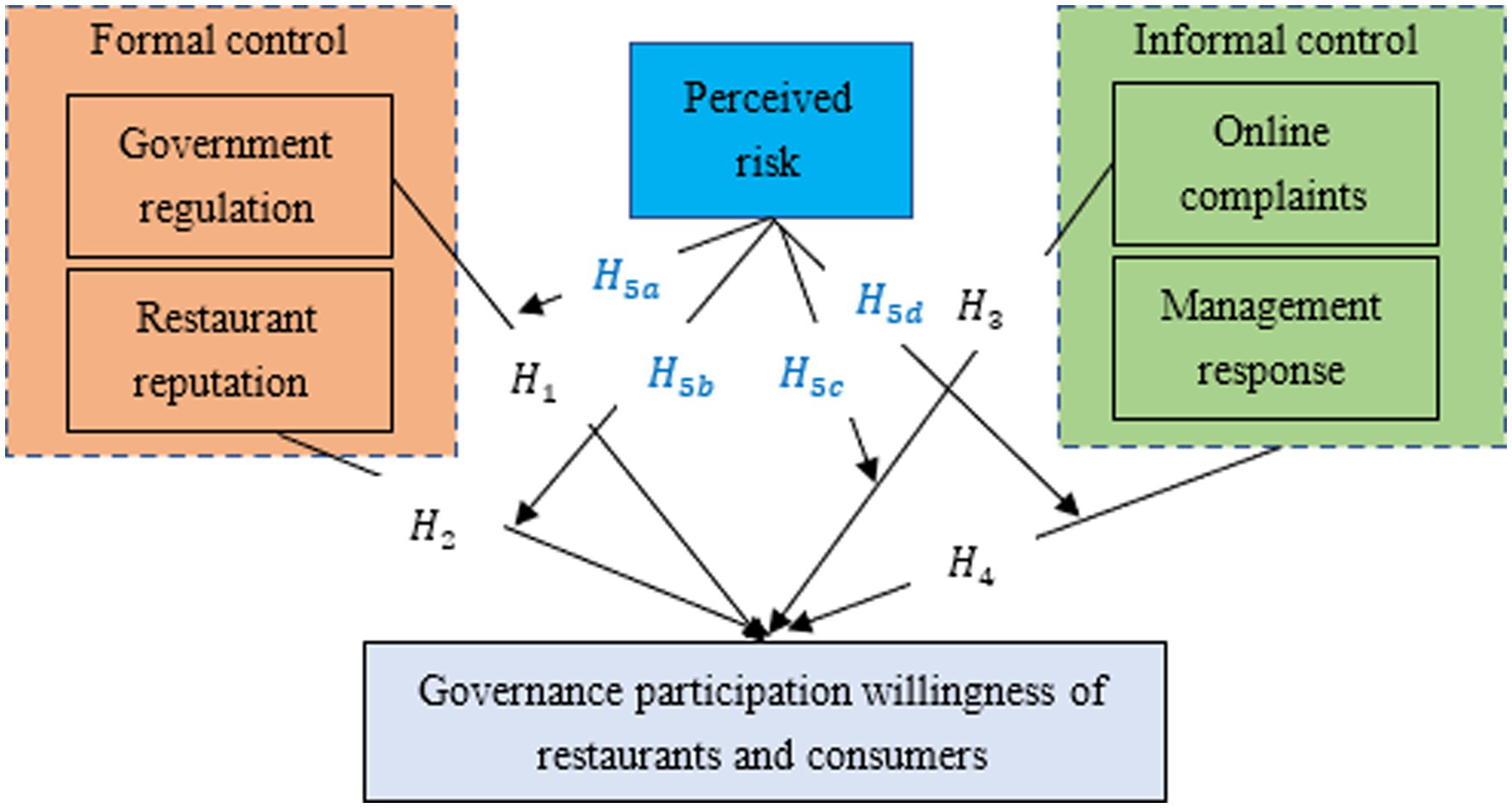
Figure 2. Research model for governance participation willingness of restaurants and consumers. The figure illustrates the influences of formal and informal control elements on governance participation willingness by restaurants and consumers, respectively. It also shows the moderating effects of perceived risks by restaurants and consumers on these influences.
3.3. Research hypotheses
3.3.1. Influences of formal control elements on governance participation willingness of restaurants and consumers
Process and result controls are classified as formal control elements given their emphasis on reward or punishment as a means to control the system (Liu et al., 2017). The government is the supplier of systems, government regulations on OFD platform constitute the control mechanism in platform governance, and the control objectives are regarded as the platform governance criteria (Janowski et al., 2018). Through arrangement of systems, the government guides platforms to meet for the public value of ensuring food safety while achieving their own economic benefits (Martin et al., 2017; Ganapati and Reddick, 2018). Therefore, this paper takes government regulation as one process control element. Accordingly, the following hypothesis is proposed:
H1: Government regulation has a positive influence on the governance participation willingness of OFD platform restaurants and consumers.
Reputation, as society’s cognition about an enterprise’s past behaviors (Kreps and Wilson, 1982), affects that enterprise’s survival and development (Rayner, 2004; Brown et al., 2006). Therefore, reputation can be taken as a result control element to measure the control effect (Jiang et al., 2021). In addition, reputation has an implicit incentive effect on consumers’ evaluations (Sparks et al., 2016). It is more important that reputation can constrain restaurants to reduce their opportunistic behaviors and drive them to make efforts to improve goods and service quality so as to gain consumers’ trust (Sthapit, 2019). Restaurants’ pursuit for reputation can serve as a mechanism by which they internalize interests (Toubia & Stephen, 2013), motivating OFD platform stakeholders to participate in governance. Accordingly, the following hypothesis is advanced:
H2: Restaurant reputation has a positive influence on the governance participation willingness of OFD platform restaurants and consumers.
3.3.2. Influences of informal control elements on governance participation willingness of restaurants and consumers
Informal control elements are those elements that help achieve governance objectives through self-management, etc., with a focus on social or human elements’ influences on platform management systems (Choudhury and Sabherwal, 2003). As an element related to the people interacting with the platform ecological environment, consumer online complaints can be regarded as an informal control element (Jiang et al., 2021). The serious information asymmetries existing in online platforms make consumers increasingly judge product quality and suitability based on online evaluations from previous consumers (Kwark et al., 2014); accordingly, online complaints can influence the economic returns of restaurants or platform (Sthapit and Bjork, 2019) and also positively affect other consumers’ complaints (Dolan et al., 2019), driving the restaurants to take measures for improving the quality of its commodities and service (Sahin et al., 2017; Moon et al., 2019). Accordingly, the following hypothesis is proposed:
H3: Online complaints have a positive influence on the governance participation willingness of OFD platform restaurants and consumers.
A restaurant’s active response to consumers’ evaluations can enhance consumers perceived credibility of that restaurant, thereby affecting existing and potential consumers’ evaluations and weakening the negative reputation influence of negative evaluations on the restaurant (Chen et al., 2019; Armas-Cruz et al., 2022). Industrial management under modern information technology is gradually changing from a management mode of passively knowing consumers’ evaluations to one of actively responding consumers and interacting with them; this mode has proven to help restaurants to increase benefits, etc. (Xie et al., 2017). Accordingly, the following hypothesis is offered:
H4: Restaurant management response has a positive influence on the governance participation willingness of OFD platform restaurants and consumers.
3.3.3. Moderating effects of risks perceived by restaurants and consumers
Government regulation resources are objectively scare, and the government, as a party disadvantaged in terms of possessing OFD production and operation information, has bounded rationality, which results in limited ability of the government for platform regulation (Antle, 1999; Moruzzo et al., 2020). Therefore, the government must adjust its regulation methods and strength according to the risk degree of the platform operation while also carrying out its regulation responsibility over OFD platforms. Accordingly, the following hypothesis is proposed:
H5a: The positive influence of government regulation on the governance participation willingness of OFD platform restaurants and consumers is moderated by perceived risks, and the effect is positively correlated with the perceived risks.
When consumers and restaurants, etc. perceive high risks for participating in an OFD platform, negative emotions will be caused to different degrees. For example, negative media reports or adverse evaluations, etc. will impact restaurant reputations (Syed, 2019). Therefore, when the increase of perceived risk leads to reputation damage, the governance participation willingness of restaurants may be raised. Accordingly, the following hypothesis is advanced:
H5b: The positive influence of restaurant reputation on the governance participation willingness of OFD platform restaurants and consumers is moderated by perceived risks, and the effect is positively correlated with the perceived risks.
An OFD platform directly connects dispersed food producers, operators, and consumers based on the Internet; in such circumstances, online complaints become one important method for solving food quality and service problems occurring in online consumption. When consumers’ perceived risks increase, the number of online complaints will rise, and the governance willingness of the restaurant and consumers will be enhanced. Accordingly, the following hypothesis is stated:
H5c: The positive influence of online complaints on the governance participation willingness of OFD platform restaurants and consumers is moderated by perceived risks, and the effect is positively correlated with the perceived risks.
The rapid rise of OFD platforms is based on the quick development of information technology. Therefore, restaurants can reply rapidly to the online complaints or various questions from consumers during the platform operation. The stronger the risks perceived by a restaurant, the more attention the restaurant may pay to solving consumers’ online complaints, making improvement to guard against consumers’ adverse evaluations, and so on, to reduce current losses and achieve long-term benefit objectives as far as possible. Accordingly, the following hypothesis is proposed:
H5d: The positive influence of restaurant management responses on the governance participation willingness of OFD platform restaurants and consumers is moderated by perceived risks, and the effect is positively correlated with the perceived risks.
4. Research method and data collection
4.1. Development of scales for governance participation willingness of restaurants and consumers
An OFD platform is a typical bilateral market4, and restaurants and consumers are the most direct stakeholders. Accordingly, this paper develops two scales for governance participation willingness, in the online Supplementary Tables S1, S2, for these two research objects, respectively. These scales have roughly similar contents, with only a few entries being different. Each scale has six dimensions, i.e., government regulation, restaurant reputation, online complaints, management response, perceived risk, and governance participation willingness, which are measured using a seven-point Likert scale. The items in the government regulation dimension were designed mainly by referencing the research results obtained by Lewis et al. (2003) and Xu et al. (2012). The items in the restaurant reputation, online complaint, management response, perceived risk, and governance participation willingness dimensions were based on the research results obtained by McKnight et al. (2002), Wu (2013), Pavlou and Gefen (2004), Leung et al. (2019), and Jiang et al. (2021), respectively. Each dimension contains three items, and each scale contains 18 items in total.
As described in detail in the next sections, we collected data through a questionnaire survey. First, to analyze the scale items and screen substandard items so as to verify the reliability and validity of the scales, we then conducted a pre-survey and collected 190 valid questionnaires in total. The formal questionnaire survey then was carried out on the basis that the pre-survey questionnaire was determined to have good reliability and validity, and 946 valid questionnaire samples were collected in total. The study in this paper is performed gradually according to the following steps: questionnaire design, pre-survey and data collection, verification of scale rationality, formal survey and data collection, and verification of collection reliability.
To ensure the scientific validity and reliability of the survey, it was performed by Wuxi Market Supervision Bureau, China. Wuxi Market Supervision Bureau randomly distributed questionnaires to restaurants with an established presence on the OFD platform, and the questionnaires were filled in by legal persons representing the restaurants or their designated persons. The consumer survey was carried out by creating an online link to the survey website, and the link was shared on social media to be propagated to more consumers. The respondents selected in this paper had to have the experience in purchasing and consuming OFD food and those not meeting this requirement were rejected for the survey. Before respondents could start to fill in the survey questionnaires, they provided informed consent for the survey by reading the first page of the survey questionnaire.
4.2. Questionnaire pre-survey and scale verification
4.2.1. Analysis of scale items
Before the formal survey in this paper, pre-survey and data collection were performed and scale reliability was verified, for the purpose of preparing for the formal survey, to verify whether the designed scale is rational. Compared with formal survey, the pre-survey had a small sample size. The sample size for the pre-survey in this paper was 190, including 81, and 109 samples from restaurant legal persons (operators), and consumers, respectively. The analysis of scale items was as follows: items were ranked by total score, and a high-score and a low-score group were eliminated by screening. Then, we conducted mean score difference significance testing between the item scores in the high-score group and those in the low-score group using an independent samples t-test. If the critical ratio (CR) of an item is less than 3 and p > 0.05, this item should be deleted; otherwise, it should be retained (Wu, 2000). As can be discerned in the online Supplementary Table S3, the CR values of all items in the scales of participation willingness designed in this study are more than 3, with the significance level reached (p < 0.001), indicating that all measurement items in the developed scales are feasible.
4.2.2. Reliability test
The corrected item total correlation (CITC)5 values and Cronbach’s α values6 of the scale items were calculated with the software SPSS to verify the reliability of the scales. If the CITC value is less than 0.4 or α value is less than 0.7, the item should be deleted; otherwise, it should be retained (Wu, 2000). As can be discerned in the online Supplementary Table S4, the CITC values of all scale items in the pre-survey samples are more than 0.4, deletion of any item cannot increase the α values of subscales, and all α values conform to the criterion of more than 7, so all measurement items in the scales for governance participation willingness of restaurants and consumers are suitable.
4.2.3. Exploratory factor analysis
A measure test was conducted on pre-survey samples using a Kaiser-Meyer-Olkin (KMO)7 test. This aimed to determine whether the designed scale items satisfy the conditions for factor analysis. The results of pre-survey samples of restaurants and consumers show that the KMO values of all six dimensions are more than 0.7, indicating that there are many common factors between variables and the factor analysis is suitable. A mature scale where the scale facet structure has been determined and factor analysis of individual dimension can be conducted for subscale items, respectively (Wu, 2000), was used in the questionnaire formulation process in this study. Accordingly, in the pre-survey, exploratory factor analysis was conducted for six dimensions using the principal component analysis method coupled with the maximum variance orthogonal rotation method to determine the factor structure of each potential variable. The three items of each six dimensions in the scale can be extracted as one principal component, and the cumulative variance interpretation rates of the results of both pre-survey questionnaires are more than 60%. The factor loading coefficient8 values of all items conform to the criterion of more than 0.5, indicating that all items constituting the scale have significant contributions and clearly form six dimensions. Therefore, all items in the proposed scale for restaurant and consumer governance participation willingness are suitable.
4.3. Questionnaire survey and scale verification
4.3.1. Reliability and validity test
The Cronbach’s α value and CITC were selected to conduct reliability test for the formal survey sample data. Based on Tables 1, 2, the α values of both questionnaire samples for restaurants and consumers are greater than 0.7, indicating that the sample data have good reliability and internal consistency. The CITC value of each item in the questionnaire samples for restaurants and consumers is more than 0.4, further indicating that the scales have good reliability.
The KMO value, communality,9 variance interpretation rate value,10 and factor loading coefficient value were selected to test the structural validity of the scales, and the KMO values of sample data of restaurants and consumers are 0.850 and 0.878, respectively. In the two groups of sample data, the communality values of all items are higher than 0.4, and the cumulative variance interpretation rates of six dimensions in two scales are 79.789 and 79.573%, respectively. This meets the criterion of a score higher than 70%, indicating that the information content of each dimension can be effectively extracted. The loading values obtained through component matrix rotation for all dimensions in the scales satisfy the criterion of being more than 0.5, indicating that all dimensions can be analyzed as important variables. In addition, the results obtained through component matrix rotation coincide with the scales and dimensions designed in the research plan, indicating that the questionnaire samples have high validity. The above data are shown in Tables 1, 2.
4.3.2. Model fitting degree test
The Chi-squared/degrees of freedom (CMIN/DF), normed fit index (NFI), incremental fit index (IFI), Tucker-Lewis index (TLI), comparative fit index (CFI), goodness of fit index (GFI), and root mean square error of approximation (RMSEA) were used to test the fitting degrees of the structural models as shown in Figures 3, 4, and the results are shown in Table 3. Table 3 indicates that the overall fitting degree of the model is satisfying (Gefen et al., 2000), verifying the rationality of the assumed model’s structure.
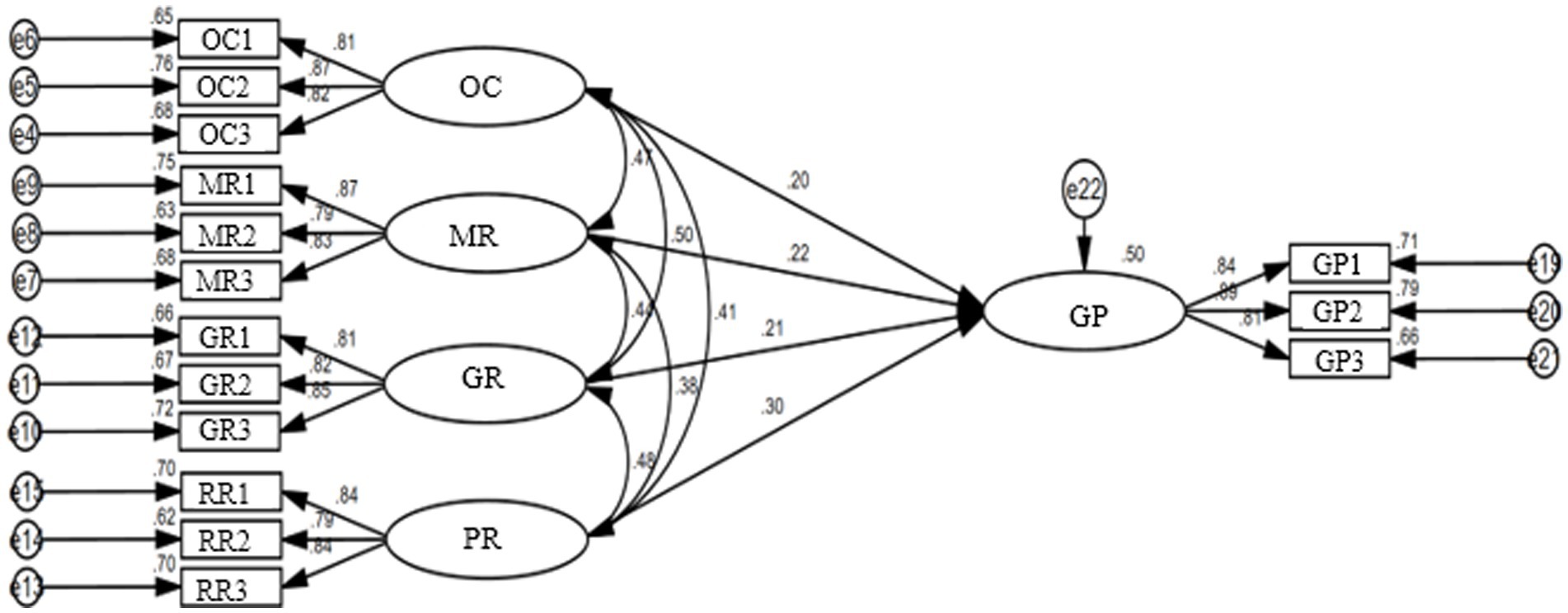
Figure 3. SEM of governance participation willingness of restaurants. OC, Online complaints; MR, Management response; GR, Government regulation; PR, Perceived risk; GP, Governance participation.
4.3.3. Test of convergent validity and discriminant validity
According to the assumed SEM, the composite reliability (CR)11 and average variance extracted (AVE)12 were used as evaluation criteria for convergent validity, and the results are shown in Tables 1, 2. The data show that the CR values of the questionnaires for both restaurants and consumers conform to the criterion of exceeding 0.7, and the AVE values conform to the criterion of exceeding 0.5 (Fornell and Larcker, 1981), indicating that these two questionnaires have good convergent validity.
Discriminant validity refers to a situation when there are multiple different dimensions in a scale, and there are varied differences in observed values between various dimensions so that any two dimensions can be distinguished from each other. In Tables 4, 5, the diagonal lines indicate the square root values of AVEs for various dimensions, and the values below the square root values of AVE are correlation coefficients of this dimension with other dimensions. The results demonstrate that the correlation coefficients between any two of these five dimensions, i.e., government regulation, restaurant reputation, online complaint, management response, and governance participation willingness, are smaller than corresponding square root values of AVE, indicating that both scales for governance participation willingness of restaurants and consumers have good discriminant validity (Fornell and Larcker, 1981).
5. Results analysis
5.1. Statistical characteristics of samples
In this paper, 946 valid questionnaire survey samples were collected, including 337 from restaurant legal persons (operators) and 609 from consumers. Tables 6, 7 give the statistical information of restaurant operator samples and that of consumer samples, respectively. For the restaurant operator questionnaire survey samples, 56.38% of operators were male, 79.23% of operators were aged below 46, and 63.20% of operators have operating time of fewer than 3 years, reflecting the fact that the online restaurant industry is a new format of food consumption only emerging in recent years.
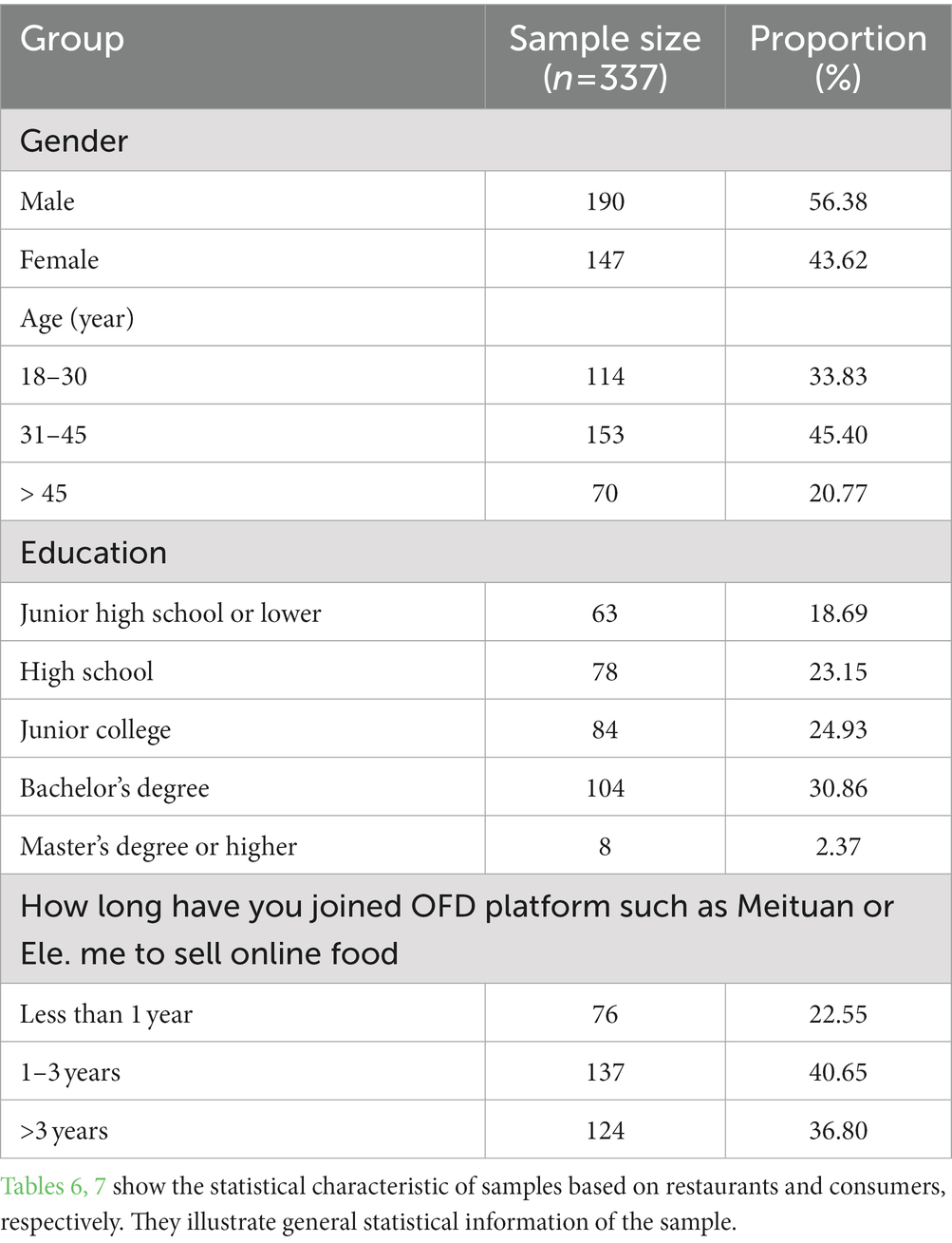
Table 6. Individual characteristic information of respondents – restaurant legal persons (operators).
For the consumer questionnaire survey samples, female consumers accounted for 52.38%. Over 84% of consumers were aged below 46, and in terms of occupations, most were employees of enterprises and public institutions or students. This coincides with the present situation that OFD is a novel restaurant supply mode with younger demographics being the main consumers (Bates et al., 2020; Roy Morgan Research, 2020; Statista, 2023).
5.2. Path analysis of SEM
To test the research hypotheses, path analysis of SEM was performed using the software AMOS. According to the results in Table 8, based on the restaurant samples, it can be seen that government regulation, online complaints, restaurant reputation, and restaurant management responses have significant positive influences on restaurants’ governance participation willingness (β = 0.209, p < 0.05; β = 0.198, p < 0.01; β = 0.297, p < 0.001; β = 0.218, p < 0.001). Based on the consumer samples, government regulation, online complaints, restaurant reputation, and restaurant management responses similarly have significant positive influences on consumers’ governance participation willingness (β = 0.167, p < 0.001; β = 0.184, p < 0.01; β = 0.185, p < 0.001; β = 0.306, p < 0.001). Therefore, H1, H2, H3, and H4 are upheld.
5.3. Analysis of moderating effects test
The moderating effects of perceived risks were tested using the LMS model by referencing the methods of Kelava et al. (2011) and Jiang et al. (2021). The interactive relationships of four control elements with the perceived risk element were constructed separately; in other words, the respective product terms of government regulation, restaurant reputation, online complaints, and restaurant management responses with perceived risk were obtained. The influences of the product terms on the platform governance participation willingness were observed in order to obtain the results of moderating effects test.
Based on the restaurant samples, Table 9 indicates that the OFD food safety risks perceived by restaurants significantly positively moderate the positive influences of the government regulation, restaurant reputation, online complaints, and restaurant management response on their governance participation willingness (β = 0.264, p < 0.001; β = 0.364, p < 0.001; β = 0.325, p < 0.001; β = 0.292, p < 0.01); therefore, H5a, H5b, H5c, and H5d are all upheld. Based on the consumer samples, the risks perceived by consumers significantly positively moderate the positive influences of the government regulation and online complaints on consumers’ governance participation willingness (β = 0.076, p < 0.05; β = 0.100, p < 0.01), but the influences of the restaurant reputation and restaurant management responses on consumers’ governance participation willingness are not moderated by the perceived risks (β = 0.066, p > 0.05; β = 0.051, p > 0.05); therefore, H5b and H5d are not upheld.
6. Discussion
Based on the control theory, this paper has constructed a research framework for the governance participation willingness of restaurants and consumers under the moderating effects of perceived risks. It explores the influences of control elements on the governance participation willingness of both restaurants and consumers and verifies the moderating effects of perceived risk element on the influences. Figure 5 shows the path analysis results of research model, and Table 10 summarizes all hypotheses and corresponding test results.
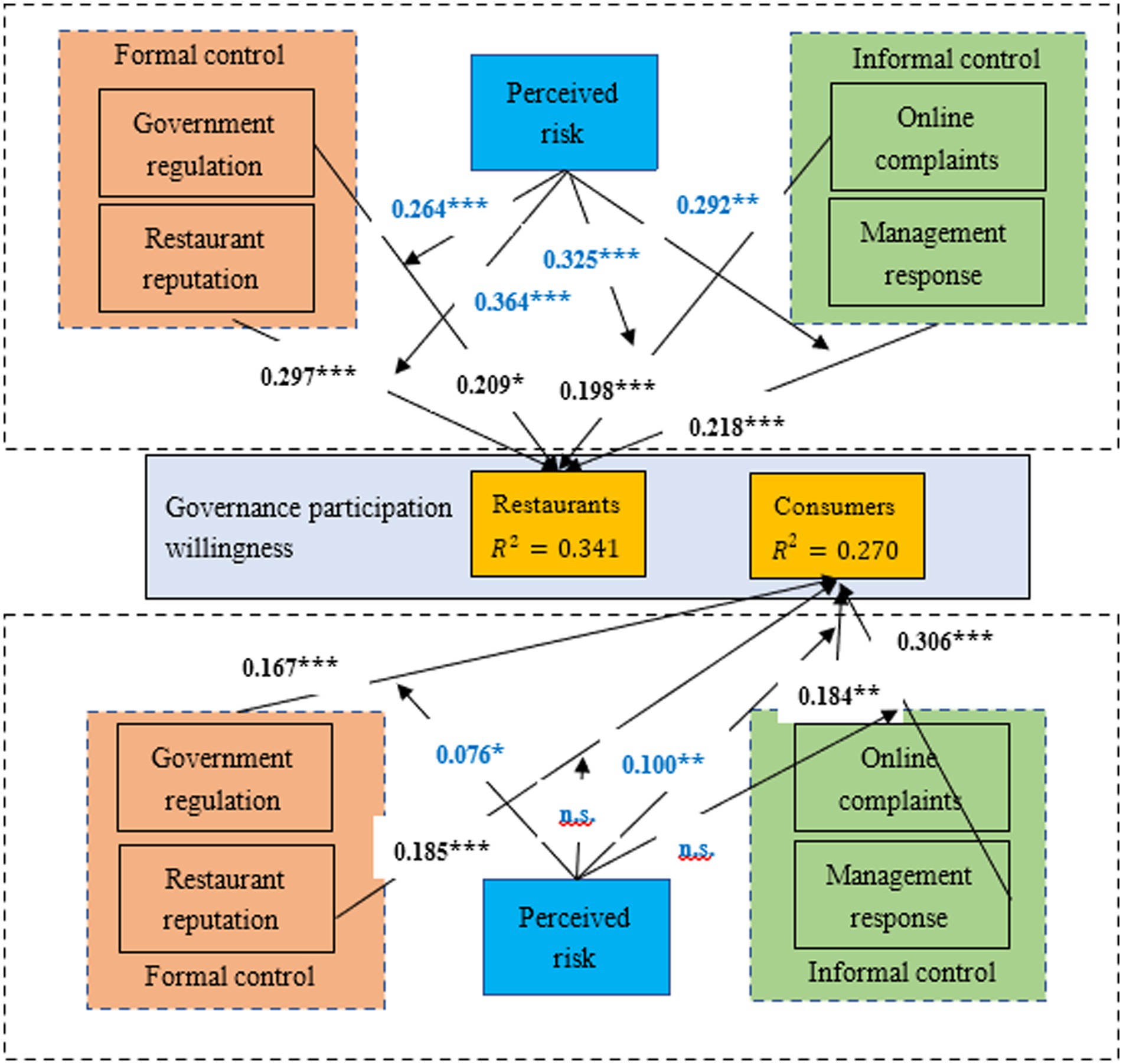
Figure 5. Path analysis results of research model. The figure shows all the path analysis results in accordance with hypotheses in the research. * Sig. at p < 0.05; ** Sig. at p < 0.01; *** Sig. at p < 0.001.
Table 10 indicates that the government regulation positively influences the governance participation willingness of restaurants and consumers and the influences are moderated positively by the food safety risks perceived by restaurants and consumers; in other words, H1 and H5a are upheld. This result coincides with the viewpoints of Martin et al. (2017), Ganapati and Reddick (2018), and Jiang et al. (2021) and indicates that government authorities have an irreplaceable role in OFD platform governance. The serious information asymmetry and complex stakeholder network in the online restaurant industry need the government to encourage other platform stakeholders to engage in joint governance while also performing its regulation responsibility.
H2 is upheld, indicating that restaurant reputation significantly influences the governance participation willingness of both restaurants and consumers, and this result coincides with the research conclusion of Sthapit (2019); in other words, the implicit incentive of reputation drives consumers’ evaluation participation and motivates restaurants to take corresponding remedy measures against negative evaluations to maintain their own reputation, thereby gaining consumer trust and long-term benefits. For the restaurant samples, the path coefficient of restaurant reputation (β = 0.297) is higher than those of government regulation, online complaints, and restaurant management response (β = 0.209; β = 0.198; β = 0.218), indicating that the influence of restaurant reputation on restaurant governance participation willingness is the most significant. Meanwhile, the moderating effect of perceived risks on the positive influence of restaurant reputation on governance participation willingness of restaurants is the most evident (β = 0.364), indicating that restaurants consider the influence of reputation as most important; in particular, the stronger the risk perceived by a restaurant, the more likely the restaurant will actively participate in OFD food safety risk governance.
H3 and H4 were upheld, indicating that online complaints and restaurant management response significantly influence the governance participation willingness of both restaurants and consumers. Consumers’ online complaints provide valuable opinions that restaurants can use to increase their own competitiveness. Thus, a complaint mechanism can drive restaurants to become more involved in platform governance, and this conclusion is consistent with the viewpoint of Dolan et al. (2019). The he positive influence of online complaints exerted by consumers’ perceived food safety risk in moderating consumers’ governance participation willingness is the most evident (β = 0.100), indicating that the stronger the risk perceived by a consumer, the more likely the consumer will be to pursue a solution through online complaints, thus driving the restaurant and consumers to more actively participate in governance. The active response of restaurant management to negative evaluation reflects the platform’s attitude, enhancing the communication between consumer and restaurant, and can motivate consumers’ willingness for re-participating in governance, thereby forming a virtuous interaction cycle. Figure 5 shows that for the consumer samples, the path coefficient of restaurant management response (β = 0.306) is higher than those of government regulation, restaurant reputation, and online complaints (β = 0.167; β = 0.185; β = 0.184), indicating that the restaurant management response element best drives the governance participation willingness of consumers. This result supports the viewpoint of Xie et al. (2017) that management responses are helpful for platform development.
Based on the questionnaire survey carried out among restaurants, H5a, H5b, H5c, and H5d are all upheld, indicating that the risk perceived by restaurants has a significant positive moderating effect on the relationships between control elements and restaurants’ governance willingness. However, based on the questionnaire survey among consumers, only H5a and H5c are upheld, but H5b and H5d are not; in other words, it was found that the risk perceived by consumers does not moderate the relationships of restaurant reputation and restaurant management response with restaurants’ governance participation willingness. This result indirectly indicates that restaurants are direct beneficiaries of platform governance, especially when they take into account the risks perceived by themselves and consumers for the purpose of pursuing long-term benefits. This coincides with the viewpoint of Hartl et al. (2016).
7. Conclusion, policy implications and future work
Given the background of serious information asymmetries in the online restaurant industry, this paper constructed a research framework for analyzing the governance participation willingness of restaurants and consumers under the moderating effects of perceived risks. Drawing on the perspective of control theory, this study examines how different control elements influence the governance participation willingness of restaurants and consumers and analyzes the moderating effects of perceived food safety risks on such willingness. Results show that both formal and informal control elements have significant promoting effects on both restaurant and consumer participation in platform food safety risk governance. Perceived risks have partially significant moderating effects on this relationship. When restaurants perceive strong risks, the control elements can more effectively arouse their governance participation willingness; however, when consumers perceive strong risks, only some of the studied control elements can more effectively arouse consumers’ governance participation willingness. Restaurants consider reputation to best arouse their governance participation willingness, whereas consumers believe that the restaurant management response element best arouses their governance participation willingness.
The research results of this paper have some policy value: Although the government and the platform both play indispensable roles in the OFD food safety risk governance, the relevant effects of restaurants and consumers should not be neglected. The government and platform should encourage consumers to engage in active discussions about restaurants’ service or food safety issues using online complaints or through the platform, so as to motivate restaurants to participate in platform governance for the purpose of protecting their reputation. The OFD platform should urge restaurants well-established on the platform to actively respond to and remedy consumers’ negative evaluations in order to maintain the reputation of the platform and restaurants and further motivate consumers to use the platform and engage in governance. Of course, it must be noted that the data used in this study were from China, and the research results should be further verified with data from other countries.
The “Internet +” new economy has given birth to the online restaurant industry – a novel food consumption format, and driven it to be rapidly developed in the world. The OFD food in the western developed countries, just as that in China, is also produced and processed in a standardized manner and characterized by convenience, and relatively low price, etc., and it also brings huge change of food environment. According to the estimation by Statista (2023), the income of the online restaurant industry will reach 354.1 billion US dollars in China in 2023, which accounts for 38.91% of the global income, and it will be 231.3 billion US dollars in USA and 34.7 billion US dollars in India. China owns the biggest OFD food market in the world. Young population provides the main consumers of OFD food, and China has the largest population of young consumers and the largest population of university undergraduate and graduate students, which are incomparable by other countries in the world. It can be foreseen that OFD industry, including restaurants, will be developed faster in China in the future. In this sense, China’s online restaurant industry is characterized by rapid development, numerous users, large scale, and high penetration, so study on the nutrition quality status of China’s OFD food is unique, proactive, and representative.
Of course, this study has some limitations. For example, the study in this paper explores the influences of formal and informal control elements on the governance willingness of restaurants and consumers separately in theory. However, this paper does not take into account the complementary or substitution effect generated when both formal and informal elements occur simultaneously, in other words, the informal control elements may have moderating effects on the formal control elements. This paper proposes a theoretical framework for collaborative participation by multiple subjects. Owing to the complexity of this framework, the complementary or substitute effect is not taken into further consideration. Therefore, future studies can take this influence element into full consideration. Moreover, the respondents in this paper are restaurants and consumers, for which the reason is that the data on these two are easier to obtain than that on governments. Consequently, future studies can explore other control relationships (e.g., platform and government) in the model with data on governments, to further verify the effectiveness of the model in this paper. In addition, the survey data in this paper is from China, so the research results are to be further verified with data from other countries or other online restaurant platforms.
Data availability statement
The original contributions presented in the study are included in the article/Supplementary material, further inquiries can be directed to the corresponding author.
Ethics statement
The studies involving human participants were reviewed and approved by the Ethical Approval was received from the Ethics Committee of Jiangnan University. All methods and procedures in this study were confirmed to the ethics guidelines of the Declaration of Helsinki and followed the ethical standards of the relevant guidelines and regulations. Respondents’ informed consent was obtained on the first page of the questionnaire before commencement of data collection. The patients/participants provided their written informed consent to participate in this study.
Author contributions
XD, KQ, and LW jointly conceptualized the research study, planned the data collection and analysis, and interpreted data. XD and KQ conducted data collection, data analysis, and drafted the initial manuscript. LW provided oversight and contributed to writing the manuscript. All authors have read and approved this manuscript.
Funding
LW acknowledged support by the National Social Science Fund of China: Research on social co-governance of food safety risks and cross-border cooperative governance mechanism (grant number 20&ZD117).
Acknowledgments
The authors are grateful to the referees for their valuable comments and their helps on how to improve the quality of our paper.
Conflict of interest
The authors declare that the research was conducted in the absence of any commercial or financial relationships that could be construed as a potential conflict of interest.
Publisher’s note
All claims expressed in this article are solely those of the authors and do not necessarily represent those of their affiliated organizations, or those of the publisher, the editors and the reviewers. Any product that may be evaluated in this article, or claim that may be made by its manufacturer, is not guaranteed or endorsed by the publisher.
Supplementary material
The Supplementary material for this article can be found online at: https://www.frontiersin.org/articles/10.3389/fpsyg.2023.1149538/full#supplementary-material
Footnotes
1. ^"Ghost kitchens," also called "Cloud kitchens" or "Dark kitchens," refers to a restaurant that does not have a dining area and waitstaff but only provides food for distribution (Li et al., 2020).
2. ^Opportunistic behavior refers to behaviors whereby, in the case of information asymmetry, people do not completely and/or truthfully disclose all information and are engaged in other activities benefiting themselves at the cost of others, such as false advertisement, patent plagiarism, violation of laws and regulations, and tax evasion (Williamson, 1985).
3. ^Platform ecosystem is an economic community centered in a platform of environment or condition that can provide a service to consumers and formed by integrating other enterprises that provide resources needed for consumers in consumption (Tiwana, 2018).
4. ^A bilateral market refers to a market in which two groups of stakeholders need to perform transactions through an intermediate layer or platform and the income of one group depends on the quantity of the other group of stakeholders (Armstrong, 2006).
5. ^A CITC test can identify the correlation of each variable with the population, and a variable with a CITC value less than 0.4 needs to be deleted.
6. ^If the Cronbach’s coefficient is more than 0.7, it indicates that the reliability is high. If the Cronbach’s coefficient is less than 0.35, it indicates that the reliability is low, so the variable should be deleted (Guielford, 1965).
7. ^A KMO test will determine the inter-variable correlation by comparing the simple correlation coefficient and partial correlation coefficient between various variables. If the partial correlation coefficient is less than the simple correlation coefficient, the correlation is stronger. This is used to determine the suitability degree of information extraction. The closer the KMO value is to 1, the higher the suitability. It is generally believed that KMO values of over 0.9, 0.8–0.9, 0.6–0.8, 0.5–0.6, and below 0.5 represent very suitable, relatively suitable, general, unsuitable, and extremely unsuitable, respectively (Kaiser, 1974).
8. ^The statistical meaning of factor loading is the correlation of the ith variable with the jth common factor (dimension), that is, the weight that Xi depends on Fj. Therefore, the factor loading coefficient is used to measure the corresponding relationship between a factor (dimension) and a variable, and the criterion for this value is more than 0.5 (Hair et al., 1998).
9. ^Communality, also called "common variance," represents the information content of an item, which can be extracted. The higher the communality, the higher the degree of interpretation of the indicator by principal component, and the more the information content extracted. The criterion is generally taken as 0.4.
10. ^Variance interpretation rate is used to show how much original data a factor (dimension) contains, that is, the information extraction level. A cumulative variance interpretation rate usually ranges from 70 to 90% (Jolliffe, 2002).
11. ^Composite reliability refers to the reliability of a composite score (a new score composed of the sum of more than one scores) (Fornell and Larcker, 1981).
12. ^Average variance extracted is a statistic used to test the internal consistency of a structural variable in statistics (Fornell and Larcker, 1981).
References
Ahani, A., Nilashi, M., Ibrahim, O., Sanzogni, L., and Weaven, S. (2019). Market segmentation and travel choice prediction in Spa hotels through TripAdvisor’s online reviews. Int. J. Hosp. Manag. 80, 52–77. doi: 10.1016/j.ijhm.2019.01.003
Alsaad, A., Mohamad, R., Taamneh, A., and Ismail, N. (2018). What drives global B2B e-commerce usage: An analysis of the effect of the complexity of trading system and competition pressure. Tech. Anal. Strat. Manag. 30, 980–992. doi: 10.1080/09537325.2018.1432853
Antle, J. M. (1999). Benefits and costs of food safety regulation. Food Policy 24, 605–623. doi: 10.1016/S0306-9192(99)00068-8
Armas-Cruz, Y., Gil-Soto, E., and Morini-Marrenro, S. (2022). Monitoring hotel response management: A multidimensional approach. Int. J. Hosp. Manag. 101:103127. doi: 10.1016/j.ijhm.2021.103127
Armstrong, M. (2006). Competition in two-sided markets. Rand J. Econ. 37, 668–691. doi: 10.1111/j.1756-2171.2006.tb00037.x
Atif, Y. (2002). Building trust in e-commerce. Internet Comput. IEEE 6, 18–24. doi: 10.1109/4236.978365
Barinda, S., and Ayuningtyas, D. (2022). Assessing the food control system in Indonesia: A conceptual framework. Food Control 134:108687. doi: 10.1016/j.foodcont.2021.108687
Bates, S., Reeve, B., and Trevena, H. (2020). A narrative review of online food delivery in Australia: Challenges and opportunities for public health nutrition policy. Public Health Nutr. 1, 1–11. doi: 10.1017/S1368980020000701
Belleri, C. (2020). Deliveroo: Improving a service making IT 24 hours. Master’s Thesis. Madrid, Spain: EAE Business School.
Benson, A., Sojourner, A., and Umyarov, A. (2020). Can reputation discipline the gig economy? Experimental evidence from an online labor market. Manag. Sci. 66, 1802–1825. doi: 10.1287/mnsc.2019.3303
Brown, T. J., Dacin, P. A., Pratt, M. G., and Whetten, D. A. (2006). Identity, intended image, construed image, and reputation: An interdisciplinary framework and suggested terminology. J. Acad. Mark. Sci. 34, 99–106. doi: 10.1177/0092070305284969
Cai, R., and Leung, X. Y. (2020). Mindset matters in purchasing online food deliveries duringthe pandemic: The application of construal level and regulatory focus theories. Int. J. Hosp. Manag. 91:102677. doi: 10.1016/j.ijhm.2020.102677
Chen, W., Gu, B., Ye, Q., and Zhu, K. X. (2019). Measuring and managing the externality of managerial responses to online customer reviews. Inf. Syst. Res. 30, 81–96. doi: 10.1287/isre.2018.0781
Cheng, C. C., Chang, Y. Y., and Chen, C. T. (2021). Construction of a service quality scale for the online food delivery industry. Int. J. Hosp. Manag. 95:102938. doi: 10.1016/j.ijhm.2021.102938
China Internet Network Information Center (CNNIC) (2022). Statistical report on internet development in China. Available at: https://baijiahao.baidu.com/s?id=1725995360605237824&wfr=spider&for=pc
Cho, M., Bonn, M. A., and Li, J. (2019). Differences in perceptions about food delivery apps between single-person and multi-person households. Int. J. Hosp. Manag. 77, 108–116. doi: 10.1016/j.ijhm.2018.06.019
Choudhury, V., and Sabherwal, R. (2003). Portfolios of control in outsourced software development projects. Inf. Syst. Res. 14, 291–314. doi: 10.1287/isre.14.3.291.16563
Ding, Y., Nayga, R. Jr., Zeng, Y., Yang, W., and Snell, H. A. (2022). Consumers’ valuation of a live video feed in restaurant kitchens for online food delivery service. Food Policy 112:102373. doi: 10.1016/j.foodpol.2022.102373
Dolan, R., Seo, Y., and Kemper, J. (2019). Complaining practices on social media in tourism: A value co-creation and co-destruction perspective. Tour. Manag. 73, 35–45. doi: 10.1016/j.tourman.2019.01.017
Du, X., Dong, R., Li, W., Jia, Y., and Chen, L. (2019). Online reviews matter: How can platforms benefit from online reviews? Sustainability 11:6289. doi: 10.3390/su11226289
Eisenhardt, K. M. (1985). Control: Organizational and economic approaches. Manag. Sci. 31, 134–149. doi: 10.1287/mnsc.31.2.134
Fan, Q., and Qiu, J. (2021). The effect of social exclusion on consumers\u0027 preference for new products: A moderating effect based on self-affirmation. Journal of Nanchang University (Humanities and Social Science Edition). 5:44–55.
Filieri, R., McLeay, F., Tsui, B., and Lin, Z. (2018). Consumer perceptions of information helpfulness and determinants of purchase intention in online consumer reviews of services. Inf. Manag. 55, 956–970. doi: 10.1016/j.im.2018.04.010
Fornell, C., and Larcker, D. F. (1981). Evaluating structural equation models with unobservable variables and measurement error. J. Mark. Res. 18, 39–50. doi: 10.2307/3151312
Ganapati, S., and Reddick, C. G. (2018). Prospects and challenges of sharing economy for the public sector. Gov. Inf. Q. 35, 77–87. doi: 10.1016/j.giq.2018.01.001
Gao, X., Shi, X., Guo, H., and Liu, Y. (2020). To buy or not buy food online: The impact of the COVID-19 epidemic on the adoption of ecommerce in China. PLoS One 15:e07900. doi: 10.1371/journal.pone.0237900
Gefen, D., Straub, D., and Boudreau, M.-C. (2000). Structural equation modeling and regression: Guidelines for research practice. Commun. Assoc. Inf. Syst. 4:7. doi: 10.17705/1CAIS.00407
Gol, E. S., Stein, M.-K., and Avital, M. (2019). Crowdwork platform governance toward organizational value creation. J. Strateg. Inf. Syst. 28, 175–195. doi: 10.1016/j.jsis.2019.01.001
Grunert, K. G. (2002). Current issues in the understanding of consumer food choice. Trends Food Sci. Technol. 13, 275–285. doi: 10.1016/S0924-2244(02)00137-1
Grunert, K. G. (2005). Food quality and safety: Consumer perception and demand. Eur. Rev. Agric. Econ. 32, 369–391. doi: 10.1093/eurrag/jbi011
Gunden, N., Morosan, C., and DeFranco, A. (2020). Consumers’ intentions to use online food delivery systems in the USA. Int. J. Contemp. Hosp. Manag. 32, 1325–1345. doi: 10.1108/IJCHM-06-2019-0595
Hair, J. F., Anderson, R. E., and Tatham, R. L. (1998). Multivariate data analysis. Englewood Cliffs, NJ: Prentice Hall.
Hartl, B., Hofmann, E., and Kirchler, E. (2016). Do we need rules for “what’s mine is yours”? Governance in collaborative consumption communities. J. Bus. Res. 69, 2756–2763. doi: 10.1016/j.jbusres.2015.11.011
He, H., and Zhu, L. (2020). Online shopping green product quality supervision strategy with consumer feedback and collusion behavior. PLoS One 15:e0229471. doi: 10.1371/journal.pone.0229471
Huaan Securities (2021). In-depth report on online media industry. Available at: https://download.csdn.net/download/sysocc/81425507
Janowski, T., Estevez, E., and Baguma, R. (2018). Platform governance for sustainable development: Reshaping citizen-administration relationships in the digital age. Gov. Inf. Q. 35, S1–S16. doi: 10.1016/j.giq.2018.09.002
Jiang, G., Zhang, M., Cai, X., and Feng, X. (2021). Governance participation in shared accommodation platform: Moderating role of perceived risk. J. Hosp. Tour. Manag. 49, 112–128. doi: 10.1016/j.jhtm.2021.09.005
Jin, Y., Meng, Y., and Xu, Y. (2016). A study on what cause the lack of integrity in China's food companies[C]//food hygiene, agriculture and animal science. In Proceedings of the 2015 international conference on food hygiene, agriculture and animal science, Wuhan, Hubei, China.
Kassi, O., and Lehdonvirta, V. (2018). Online labour index: Measuring the online gig economy for policy and research. Technol. Forecast. Soc. Chang. 137, 241–248. doi: 10.1016/j.techfore.2018.07.056
Kelava, A., Werner, C. S., Schermelleh-Engel, K., Moosbrugger, H., Zapf, D., Ma, Y., et al. (2011). Advanced nonlinear latent variable modeling: Distribution analytic LMS and QML estimators of interaction and quadratic effects. Struct. Eq. Model. Multidip. J. 18, 465–491. doi: 10.1080/10705511.2011.582408
Kirsch, L. J. (1996). The management of complex tasks in organizations: Controlling the systems development process. Organ. Sci. 7, 1–21. doi: 10.1287/orsc.7.1.1
Kirsch, L. S. (1997). Portfolios of control modes and IS project management. Inf. Syst. Res. 8, 215–239. doi: 10.1287/isre.8.3.215
Kreps, D. M., and Wilson, R. (1982). Reputation and imperfect information. J. Econ. Theory 27, 253–279.
Kwark, Y., Chen, J., and Raghunathan, S. (2014). Online product reviews: Implications for retailers and competing manufacturers. Informat. Syst. Res. 25, 93–110. doi: 10.1287/isre.2013.0511
Langley, P., and Leyshon, A. (2017). Platform capitalism: the intermediation and capitalization of digital economic circulation. Finance Society 3:11–31.
Leoni, G., and Parker, L. D. (2018). Governance and control of sharing economy platforms: Hosting on Airbnb. Br. Acc. Rev. 51:100814. doi: 10.1016/j.bar.2018.12.001
Leung, X. Y., Xue, L., and Wen, H. (2019). Framing the sharing economy: Toward a sustainable ecosystem. Tour. Manag. 71, 44–53. doi: 10.1016/j.tourman.2018.09.021
Lewis, W., Agarwal, R., and Sambamurthy, V. (2003). Sources of influence on beliefs about information technology use: An empirical study of knowledge workers. MIS Q. 27, 657–678. doi: 10.2307/30036552
Li, S., Kallas, Z., and Rahmani, D. (2022). Did the COVID-19 lockdown affect consumers’ sustainable behaviour in food purchasing and consumption in China. Food Control 132:108325. doi: 10.1016/j.foodcont.2021.108352
Li, C., Mirosa, M., and Bremer, P. (2020). Review of online food delivery platforms and their impacts on sustainability. Sustainability 12:5528. doi: 10.3390/su12145528
Liu, G. (2018). The impact of supply chain relationship on food quality. Proc. Comput. Sci. 131, 860–865. doi: 10.1016/j.procs.2018.04.286
Liu, S., and Deng, Z. (2015). How environment risks moderate the effect of control on performance in information technology projects: Perspectives of project managers and user liaisons. Int. J. Inf. Manag. 35, 80–97. doi: 10.1016/j.ijinfomgt.2014.10.003
Liu, S., Wang, L., and Huang, W. W. (2017). Effects of process and outcome controls on business process outsourcing performance: Moderating roles of vendor and client capability risks. Eur. J. Oper. Res. 260, 1115–1128. doi: 10.1016/j.ejor.2017.01.020
Lu, M., Wang, R., and Li, P. (2022). Comparative analysis of online fresh food shopping behavior during normal and COVID-19 crisis period. Br. Food J. 124, 968–986. doi: 10.1108/BFJ-09-2020-0849
Martin, C. J., Upham, P., and Klapper, R. (2017). Democratising platform governance in the sharing economy: An analytical framework and initial empirical insights. J. Clean. Prod. 166, 1395–1406. doi: 10.1016/j.jclepro.2017.08.123
Martinez-Navarro, J., Bigne, E., Guixeres, J., Alcan, M., and Torrecilla, C. (2019). The influence of virtual reality in e-commerce. J. Bus. Res. 100, 475–482. doi: 10.1016/j.jbusres.2018.10.054
McCluskey, J. J. (2000). A game theoretic approach to organic foods: An analysis of asymmetric information and policy. Agric. Resour. Econ. Rev. 29, 1–9. doi: 10.1017/S1068280500001386
McKnight, D. H., Choudhury, V., and Kacmar, C. (2002). Developing and validating trust measures for e-commerce: An integrative typology. Inf. Syst. Res. 13, 334–359. doi: 10.1287/isre.13.3.334.81
Moon, H., Wei, W., and Miao, L. (2019). Complaints and resolutions in a peer-to-peer business model. Int. J. Hosp. Manag. 81, 239–248. doi: 10.1016/j.ijhm.2019.04.026
Moruzzo, R., Francesco, R., Fabio, B., Zhaozhong, Z., Jinjin, Z., Yaojia, T., et al. (2020). Urban consumer trust and food certifications in China. Foods 9:1153. doi: 10.3390/foods9091153
Munikrishnan, U. T., Huang, K., Mamun, A. A., and Hayat, N. (2021). Perceived risk, trust, and online food purchase intention among Malaysians. Bus. Perspect. Res. 11, 28–43. doi: 10.1177/22785337211043968
Nita, C. (2019). Strategic analysis of cloud kitchen—A case study. Manag. Today 9, 184–190. doi: 10.11127/gmt.2019.09.05
Oncini, F., Bozzini, E., Forno, F., and Magnani, N. (2020). Towards food platform? An analysis of online food provisioning services in Italy. Geoforum 114, 172–180. doi: 10.1016/j.geoforum.2020.06.004
Ortega, D. L., Wang, H. H., Wu, L., and Olynk, N. J. (2011). Modeling heterogeneity in consumer preferences for select food safety attributes in China. Food Policy 36, 318–324. doi: 10.1016/j.foodpol.2010.11.030
Ouchi, W. G. (1979). A conceptual framework for the design of organizational control mechanisms. Management Science 25, 833–848. doi: 10.1287/mnsc.25.9.833
Pan, M., Huang, R., Chi, M., and Hu, S. (2022). The impact of platform flexibility and controls on platform attractiveness: An empirical study from the seller's perspective. Ind. Manag. Data Syst. 122, 796–818. doi: 10.1108/IMDS-08-2021-0528
Pappas, N. (2016). Marketing strategies, perceived risks, and consumer trust in online buying behaviour. J. Retail. Consum. Serv. 29, 92–103. doi: 10.1016/j.jretconser.2015.11.007
Pavlou, P. A., and Gefen, D. (2004). Building effective online marketplaces with institution based trust. Inf. Syst. Res. 15, 37–59. doi: 10.1287/isre.1040.0015
Pichler, P., and Wilhelm, W. (2001). A theory of the syndicate: Form follows function. J. Financ. 56, 2237–2264. doi: 10.1111/0022-1082.00404
Pillai, S. G., Kim, W. G., Haldorai, K., and Kim, H. S. (2022). Online food delivery services and consumers’ purchase intention: Integration of theory of planned behavior, theory of perceived risk, and the elaboration likelihood model. Int. J. Hosp. Manag. 105:103275. doi: 10.1016/j.ijhm.2022.103275
Rayner, J. (2004). Managing reputational risk: Curbing threats, leveraging opportunities. Hoboken, NJ: John Wiley & Sons.
Rietveld, J., Schilling, M. A., and Bellavitis, C. (2019). Platform strategy: Managing ecosystem value through selective promotion of complements. Organ. Sci. 30, 1232–1251. doi: 10.1287/orsc.2019.1290
Roy Morgan Research (2020). Meal delivery services double usage in only 18 months. Available at: https://www.roymorgan.com/findings/8270-food-delivery-services-september-2019-202002030451
Sahin, I., Gulmez, M., and Kitapci, O. (2017). E-complaint tracking and online problem-solving strategies in hospitality management: Plumbing the depths of reviews and responses on TripAdvisor. J. Hosp. Tour. Technol. 8, 372–394. doi: 10.1108/JHTT-02-2017-0009
Segerson, K. (1999). Mandatory versus voluntary approaches to food safety. Agribusiness 15, 53–70. doi: 10.1002/(SICI)1520-6297(199924)15:1<53::AID-AGR4>3.0.CO;2-G
Sparks, B. A., So, K. K. F., and Bradley, G. L. (2016). Responding to negative online reviews: The effects of hotel responses on customer inferences of trust and concern. Tour. Manag. 53, 74–85. doi: 10.1016/j.tourman.2015.09.011
Statista (2023). Online food delivery in the United States. Available at: https://www.statista.com/outlook/374/109/online-food-delivery/united-states
Sthapit, E. (2019). My bad for wanting to try something unique: Sources of value codestruction in the airbnb context. Curr. Issue Tour. 22, 2462–2465. doi: 10.1080/13683500.2018.1525340
Sthapit, E., and Bjork, P. (2019). Sources of value co-destruction: Uber customer perspectives. Tour. Rev. 74, 780–794. doi: 10.1108/TR-12-2018-0176
Syed, R. (2019). Enterprise reputation threats on social media: A case of data breach framing. The Journal of Strategic Information Systems 28, 257–274. doi: 10.1016/j.jsis.2018.12.001
Tham, K. W., Dastane, O., Johari, Z., and Ismail, N. B. (2019). Perceived risk factors affecting consumers’ online shopping behaviour. J. Asian Fin. Econ. Bus. 6, 246–260. doi: 10.13106/jafeb.2019.vol6.no4.249
Tiwana, A., Konsynski, B., and Bush, A. A. (2010). Research commentary—platform evolution: Coevolution of platform architecture, governance, and environmental dynamics. Information Systems Research 21, 675–687. doi: 10.1287/isre.1100.0323
Tiwana, A. (2018). Platform ecosystem -- architecture planning, governance and strategy. Beijing, China: Peking University Press.
Toubia, O., and Stephen, A. T. (2013). Intrinsic vs. image-related utility in social media: Why do people contribute content to twitter? Marketing Science 32, 368–392. doi: 10.1287/mksc.2013.0773
Wang, J. H., Wang, H., and Sun, J. (2020). Food safety regulation strategy from the perspective of ordering platforms. Econ. Manag. 34, 79–85.
Wei, B., and Yao, Y. Q. (2020). Governance in digital leviathan risks of online food trade. J. Xiangtan Univ. 44, 40–45.
Williamson, O. E. (1985). The economic institutions of capitalism: Firms, markets, relational contracting. New York: The Free Press.
Wood, G. (2017). Unelected Power: The Quest for Legitimacy in Central Banking and the Regulatory State by Tucker. Princeton University Press 642, 456–457.
Wood, G. (2018). Unelected power: The quest for legitimacy in central banking and the regulatory state by tucker. Princeton, NJ: Princeton University Press. 642, 456–457.
Wu, L. (2013). The antecedents of customer satisfaction and its link to complaint intentions in online shopping: An integration of justice, technology, and trust. Int. J. Inf. Manag. 33, 166–176. doi: 10.1016/j.ijinfomgt.2012.09.001
Wu, L. H., Chen, X. J., and Yin, S. J. (2019). Food safety risk management from farm to fork (1st edition, October 2019). Beijing, China: China Agriculture Press.
Xiao, P., and Yang, B. (2022). Legal responsibility system of food safety management: Connotation, function and construction of the rule of law. Journal of Nanchang University (Humanities and Social Sciences Edition) 1:66–75.
Xie, K. L., So, K. K. F., and Wang, W. (2017). Joint effects of management responses and online reviews on hotel financial performance: A data-analytics approach. Int. J. Hosp. Manag. 62, 101–110. doi: 10.1016/j.ijhm.2016.12.004
Xu, H., Teo, H.-H., Tan, B. C., and Agarwal, R. (2012). Research note—effects of individual self-protection, industry self-regulation, and government regulation on privacy concerns: A study of location-based services. Inf. Syst. Res. 23, 1342–1363. doi: 10.1287/isre.1120.0416
Yin, X. R., Hong, L., and Wang, Z. (2020). Food safety regulation in the context of transactions via online platforms: An innovative mode based on co-regulation and information sharing. Contemp. Econ. Manag. 42, 46–52.
Zanetta, L. D. A., Piton Hakim, M., Barbosa Gastaldi, G., MontAlverne Juca Seabra, L., Moura Rolim, P., Guimaraes Perdomo Nascimento, L., et al. (2021). The use of food delivery apps during the COVID-19 pandemic in Brazil: The role of solidarity, perceived risk, and regional aspects. Food Res. Int. 149:110671. doi: 10.1016/j.foodres.2021.110671
Zhang, F. (2021). Research on the improvement of network food safety governance mechanism. Lanzhou Acad. J. 10, 124–132.
Zhao, P. (2017). Beyond platform responsibility: Reflections on the regulatory model of online food trading. J. East China Univ. Polit. Sci. Law 20, 60–71.
Zhao, W. (2018). Research on social responsibility of E-commerce platform. IOP Conf. Ser. Mater. Sci. Eng. 439:032063. doi: 10.1088/1757-899X/439/3/032063
Zhao, X., Lin, W., Cen, S., and Zhu, H. (2021). The online-to-offline (O2O) food delivery industry and its recent development in China. Eur. J. Clin. Nutr. 75, 232–237. doi: 10.1038/s41430-020-00842-w
Zheng, H., Xu, B., and Lin, Z. (2019). Seller’s creditworthiness in the online service market: A study from the control perspective. Decis. Support. Syst. 127:113118. doi: 10.1016/j.dss.2019.113118
Keywords: online food delivery, platform governance, food safety, control theory, perceived risk
Citation: Dai X, Qin K and Wu L (2023) Study on effect of collaborative governance participation willingness of online food delivery platform restaurants and consumers from perspective of control theory: Based on moderating effects of perceived risks. Front. Psychol. 14:1149538. doi: 10.3389/fpsyg.2023.1149538
Edited by:
Giuseppe Di Vita, University of Turin, ItalyReviewed by:
Qingli Dong, University of Shanghai for Science and Technology, ChinaYou-hua Chen, South China Agricultural University, China
Li Zhou, Nanjing Agricultural University, China
Copyright © 2023 Dai, Qin and Wu. This is an open-access article distributed under the terms of the Creative Commons Attribution License (CC BY). The use, distribution or reproduction in other forums is permitted, provided the original author(s) and the copyright owner(s) are credited and that the original publication in this journal is cited, in accordance with accepted academic practice. No use, distribution or reproduction is permitted which does not comply with these terms.
*Correspondence: Linhai Wu, d2xoNjc5OUAxMjYuY29t
 Xiaoting Dai
Xiaoting Dai Ke Qin
Ke Qin Linhai Wu
Linhai Wu